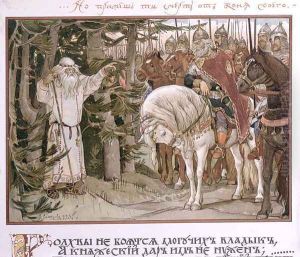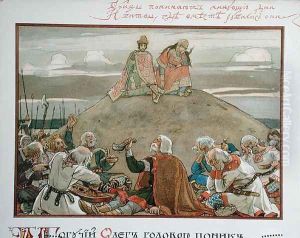V. Vaznetzov Paintings
Viktor Mikhailovich Vasnetsov, known in English as V. Vaznetzov, was a prominent Russian artist renowned for his historical and mythological subjects. Born on May 15, 1848, in the village of Lopyal in Vyatka Governorate (now Kirov Oblast), Russia, Vasnetsov was one of the key figures in Russian art who managed to bridge the gap between traditional Russian iconography and the European-oriented Russian Revival and Symbolist movements. Initially, Vasnetsov aimed to become a priest like his father, but his passion for drawing eventually led him to the St. Petersburg Academy of Arts in 1867.
During his early career, Vasnetsov was influenced by the realistic paintings of the Wanderers (Peredvizhniki), a cooperative of Russian realist artists who championed the societal role of art. However, by the late 1870s, Vasnetsov's focus shifted towards subjects drawn from Russian history and folklore, which would become the hallmark of his work. His paintings such as 'Bogatyrs' (1898) and 'The Knight at the Crossroads' (1878) are iconic examples of his fascination with medieval knights and epic heroes, blending mythical elements with a distinctive nationalistic fervor.
Vasnetsov's contributions to Russian art were not limited to canvas. He was also a gifted architect and designer, most notably involved in the design of the façade of the Tretyakov Gallery in Moscow, and the creation of stunning murals for the Cathedral of St. Vladimir in Kiev. His ability to infuse traditional Russian artistic elements with the techniques and sensibilities of contemporary European art made him a pivotal figure in the Russian Revival movement.
Throughout his life, Vasnetsov was deeply involved in various artistic societies and educational initiatives, striving to promote Russian art and heritage. His works inspired a generation of Russian artists and continued to influence the development of Russian visual culture into the 20th century. Vasnetsov died on July 23, 1926, in Moscow, but left behind a legacy that firmly established him as a pillar of Russian national art.

